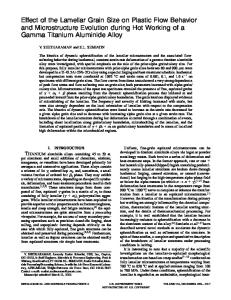Determination of the critical inclusion size with respect to void formation during hot working
- PDF / 1,498,902 Bytes
- 9 Pages / 612 x 792 pts (letter) Page_size
- 31 Downloads / 283 Views
Fig. 1--Structure of a dimple fracture showing inclusions in the center of the dimples. Magnification1540 times.
(X +dx). As the c r i t i c a l inclusion size (d*) is considered, g(x) must equal zero for x < d*. On a polished surface of the specimen the inclusions will show up as circles. The inclusions associated with cracks will in this case have a distribution function H (x). H (x) is the relative number of observed inclusion diam which are less or equal to x. This function will be calculated as a function of g(x). On a polished surface the expected number of inclusions with particle diam equal to x is directly proportional to g(x) .x. This is obvious if a cube with the sides equal to S containing one inclusion with the diam x is considered. The probability of sectioning this inclusion is x/S and if t h e r e were n inclusions the probability whould be nx/S. The frequency function for the true diam of a sectioned particle can be written as: k(x) = - x .g(x) f t.g(t)dt t=do k ( x ) = O,
_ 1__ . x . g ( x ) , x ~ do a
[i] x < do
VOLUME 6A, FEBRUARY 1975-319
I f
Q (a)
(b)
t o
Q O
b
t
(c)
r
Fig. 2 - - M i e r o c r a c k s a s s o c i a t e d with inclusions. (a) Silicate inclusion (about 85 pet SiO~) showing c r a c k f o r m a t i o n at the inclusion m a t r i x interface, 54 pct e x t e r n a l reduction. Magnification approximately 1250 times, (b) Silicate inclusion showing c r a c k s . Note the existence of a softer inclusion m a t e r i a l p r e s s e d out in the void. 54 pet e x t e r n a l reduction. Magnification approximately 1250 times. (c) Void f o r m a t i o n at a t i t a n i u m c a r b o n i t r i d e in cold r o l l e d s t a i n l e s s steel. 70 pct e x t e r n a l reduction. Magnification a p p r o x i m a t e l y 1250 t i m e s . (d) Void f o r m a t i o n between two c a r b o n i t r i d e s a f t e r 40 pet reduction. Magnification approximately 1250 times. If a s p h e r e i s r a n d o m l y s e c t i o n e d m a n y t i m e s w i t h a c u t t h e d i s t r i b u t i o n of t h e s e c t i o n e d d i a m w i l l b e :
F(x) = P ( d < _ x ) = P ( 4 0 2 / 4 - h = P (h >
8 9
x 2)
= (D -
= 1 -- ~]1 - (x/D) ~ 320-VOLUME 6A, FEBRUARY 1975
.
2 < x/2) ~/D 2 -
x ~ )/D
[2]
w h e r e D, h a n d d a r e e x p l a i n e d i n F i g . 3. A d e r i v a t i o n of e x p r e s s i o n [2] g i v e s t h e f r e q u e n c y function fD(x) for the sectioned diam, when the true d i a m i s D. f D(x) -
/~
x/D
[3]
_ x~
T h e p r o b a b i l i t y to f i n d a s e c t i o n e d d i a m w i t h a s i z e b e t w e e n s and (s + d s ) w h e n t h i s d i a m o r i g i n a t e s f r o m a p a r t i c l e w i t h a s i z e f r o m p t o (p + d p ) w i l l b e f p ( s ) 9ds . k ( p ) .dp. T h u s t h e p o s s i b i l i t y of f i n d i n g a s e c t i o n e d d i a m b e t w e e n s a n d (s + d s ) o r i g i n a t i n g f r o m a n y particle can be written as:
h(s)ds = f fp(s)k(p)dpds p=s
[4]
METALLURGICAL TRANSACTIONS A
I
!
I
!
I"
On s u b s t i t u t i n g Eq. [8] in
Data Loading...











